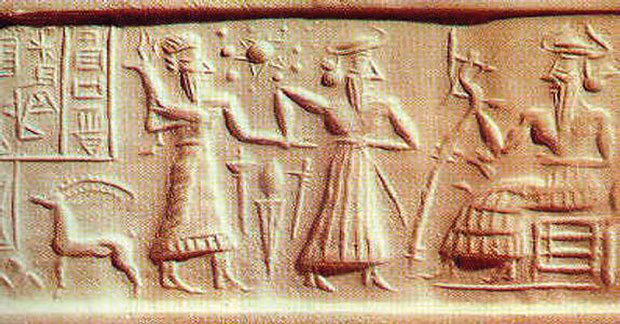Reply To:
Name - Reply Comment

 The discovery of the cylinder seal impression believed to be 6000 years old depicting 11 heavenly bodies revolving around the Sun demonstrates two significant facts: that the ancient Sumerians knew that our planetary system is heliocentric – the Sun is at the centre and all other planets including the earth revolve around it – and they knew about the existence of six more planets in the Solar system in addition to the five planets that could be seen by the naked eye. This means that the ancient Sumerians already knew that the planetary system is heliocentric, something scientifically proved by scientists like Nicolaus Copernicus, Johannes Kepler and Isaac Newton, the pioneers in modern Astronomy and they also probably knew of the existence of not only distant planets such as Uranus, Pluto and Neptune, but also of the Moons of Saturn and Jupiter.
The discovery of the cylinder seal impression believed to be 6000 years old depicting 11 heavenly bodies revolving around the Sun demonstrates two significant facts: that the ancient Sumerians knew that our planetary system is heliocentric – the Sun is at the centre and all other planets including the earth revolve around it – and they knew about the existence of six more planets in the Solar system in addition to the five planets that could be seen by the naked eye. This means that the ancient Sumerians already knew that the planetary system is heliocentric, something scientifically proved by scientists like Nicolaus Copernicus, Johannes Kepler and Isaac Newton, the pioneers in modern Astronomy and they also probably knew of the existence of not only distant planets such as Uranus, Pluto and Neptune, but also of the Moons of Saturn and Jupiter.
Astronomy in ancient Vedic civilization
Astronomy had flourished in the ancient Indian Vedic civilization and there is ample evidence to show that the Vedic astronomers knew about nine planets in the Solar system. They also had known that our planetary system is heliocentric. However, they have referred to the Sun and the Moon also as planets among the Navagraha. It could be concluded that the Sun and the Moon have been included among the Navagraha - nine planets as Astronomy had been linked to Indian Astrology from the very outset. The ancients had explored the Solar system – and in fact, the universe in a broader sense for the purpose of studying the influence of heavenly bodies on man and his environment and they had discovered it was the Sun and the Moon of all heavenly bodies that exerted the most influence on the terrestrial phenomena.
Navagraha or nine planets
The remaining seven heavenly bodies included among the Navagraha are Mangala (Mars), Budha (Mercury), Brihaspati (Jupiter), Sukra (Venus), Shani (Saturn), Rahu (North Lunar Node) and Ketu (South Lunar Node). There is a school of thought that the planets that the ancients referred to Rahu and Ketu are really Uranus and Neptune. This means that the existence of Pluto was either not known to them or was overlooked as a planet just as the Earth failed to be included among the Navagraha.
According to scholars, the earliest references to Indian Astronomy come in Rig Veda dated back to 2000 BC. Vedic Astronomy had developed independently while providing data support to the study of Astrology.
Suryasiddhantha, a treatise on Indian Astronomy
The Indian Astronomical work, Suryasiddhantha, a Sanskrit treatise on Indian Astronomy dating back to the 4th century CE describes the rules for calculating the motions of various planets and the Moon relative to various constellations. This work believed to have been revised by Indian astronomer -mathematician Aryabhata (476 – 550 AD) gives the length of the sidereal year (the duration of the Earth’s revolution round the Sun) as 365.2563627 days which is only 1.4 seconds longer than the result of the modern scientific calculation of 365.25636305 days.
Why did the ancient Indian astronomers who knew beyond any doubt that the planetary system was heliocentric and the planets were revolving around it did not count the Earth as a Graha? Why did they count the Sun as a planet knowing well it was a star?
The answers to these two questions lie in the Astronomy’s linkage to the other branch of Vedic knowledge, namely Astrology that had evolved simultaneously.
(To be continued)